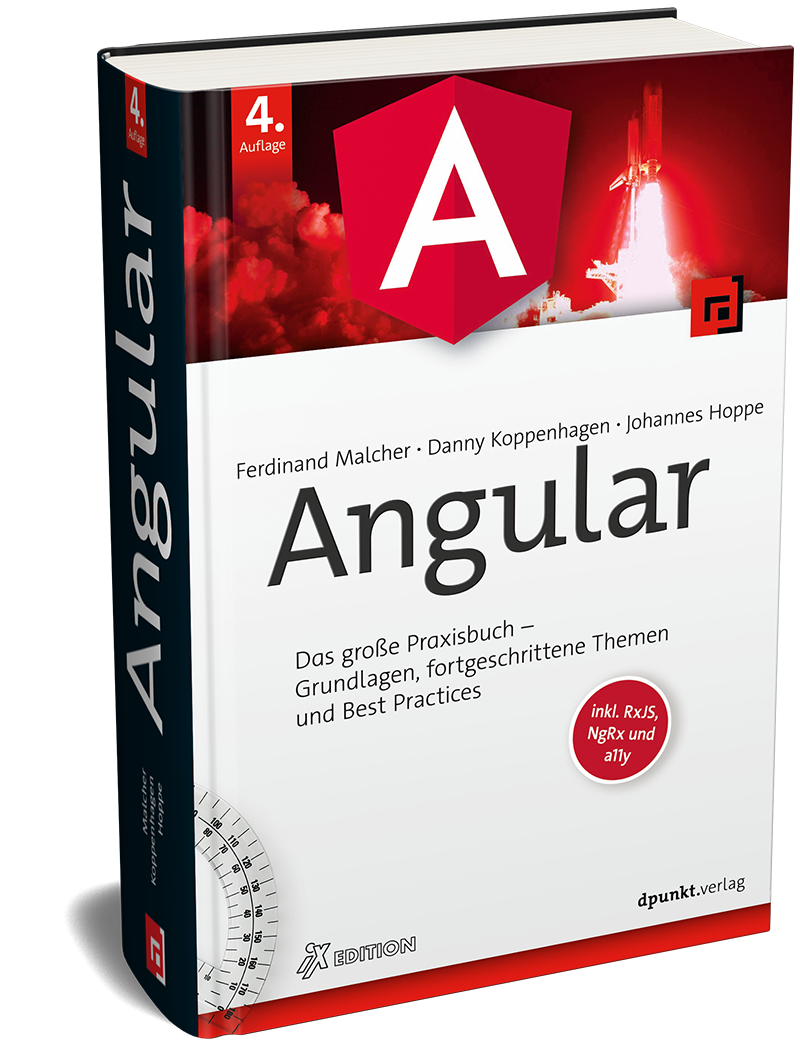| 01-components |
|
Kapitel 6 (Seite 73)
Komponenten: die Grundbausteine der Anwendung
|
| 02-property-binding |
|
Kapitel 7 (Seite 107)
Property Bindings: mit Komponenten kommunizieren
|
| 03-event-binding |
|
Kapitel 8 (Seite 123)
Event Bindings: Ereignisse in Komponenten verarbeiten
|
| 04-modules |
|
Kapitel 10 (Seite 141)
NgModule: die Anwendung modularisieren
|
| 05-di |
|
Kapitel 11 (Seite 157)
Dependency Injection: Code in Services auslagern
|
| 06-routing |
|
Kapitel 12 (Seite 175)
Routing: durch die Anwendung navigieren
|
| 07-http |
|
Kapitel 14 (Seite 225)
HTTP-Kommunikation: ein Server-Backend anbinden
|
| 08-rxjs |
|
Kapitel 15 (Seite 243)
Reaktive Programmierung mit RxJS
|
| 09-interceptors |
|
Kapitel 16 (Seite 301)
Interceptors: HTTP-Requests abfangen und transformieren
|
| 10-template-driven-forms |
|
Kapitel 18 (Seite 325)
Formulare mit Template-Driven Forms
|
| 11-reactive-forms |
|
Kapitel 19 (Seite 345)
Formulare mit Reactive Forms
|
| 12-validation |
|
Kapitel 20 (Seite 387)
Formularvalidierung: die Eingaben prüfen
|
| 13-pipes |
|
Kapitel 21 (Seite 413)
Pipes: Daten im Template formatieren
|
| 14-directives |
|
Kapitel 22 (Seite 433)
Direktiven: das Vokabular von HTML erweitern
|
| 15-lazyloading |
|
Kapitel 23 (Seite 459)
Lazy Loading: Angular-Module asynchron laden
|
| 16-guards |
|
Kapitel 24 (Seite 471)
Guards: Routen absichern
|
| 17-standalone |
|
Kapitel 25 (Seite 485)
Standalone Components: Komponenten ohne Module
|
| 16a-cypress |
|
Kapitel 26.7 (Seite 562)
Oberflächentests mit Cypress
|
| 16b-l10n |
|
Kapitel 28 (Seite 599)
Lokalisierung (l10n)
|
| 16c-i18n |
|
Kapitel 29 (Seite 605)
Internationalisierung (i18n)
|
| 16d-docker |
|
Kapitel 31 (Seite 657)
Angular-Anwendungen mit Docker bereitstellen
|
| 16e-ngrx |
|
Kapitel 32 (Seite 679)
State Management mit Redux und NgRx
|
| 16f-ssr |
|
Kapitel 33 (Seite 741)
Server-Side Rendering mit Angular Universal
|
| 16g-pwa |
|
Kapitel 34 (Seite 761)
Progressive Web Apps (PWA)
|
| 18-modern-angular |
|
Blogartikel: Modern Angular: den BookMonkey migrieren
|
